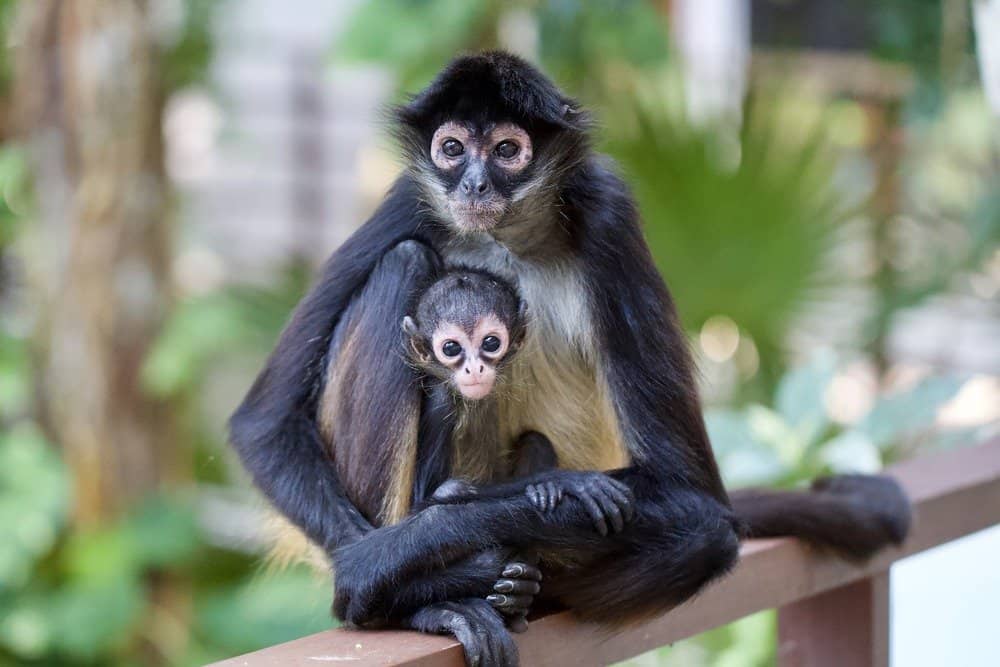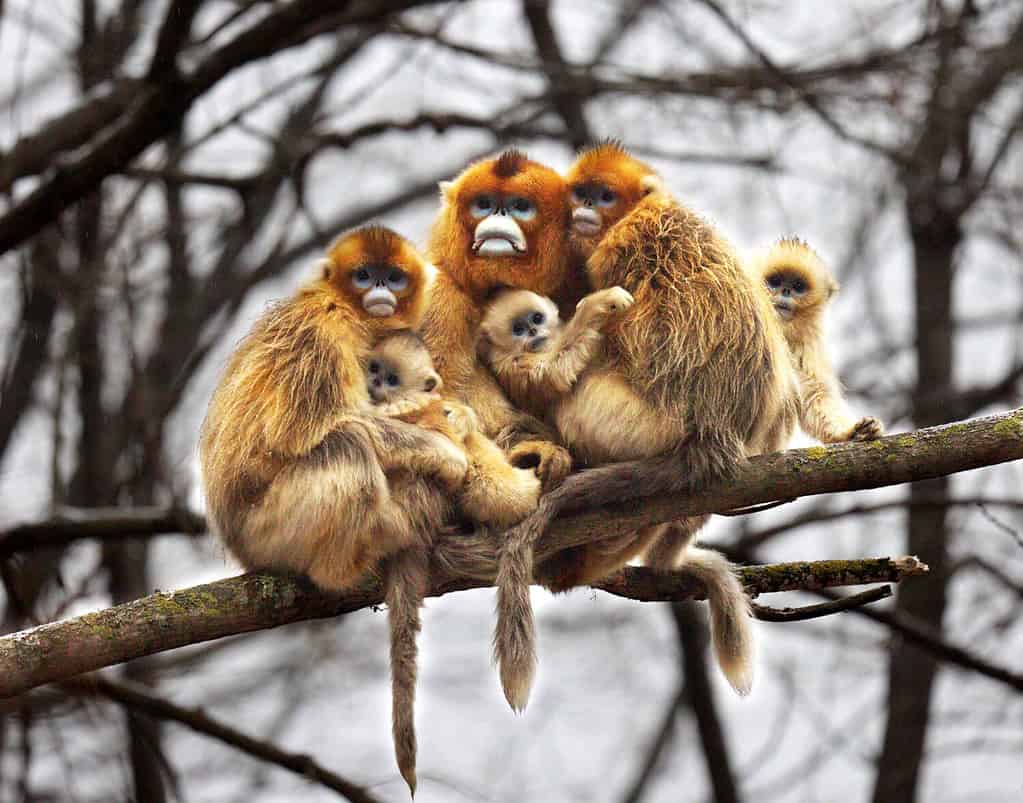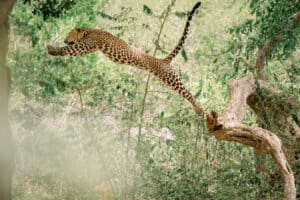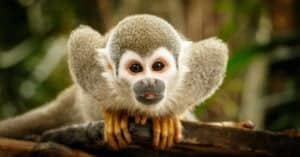Monkeys (Macaca fascicularis) are one of the most popular animals in the world. Commonly known for their adorable faces and high intelligence, many people love monkeys. There is a wide variety of monkey species, and they are found across the globe, mostly in tropical areas. Like people, monkeys are social creatures. They live in groups and communicate and interact with one another regularly. One thing that monkeys do, that many people find adorable, is hug. Is this a friendly gesture to express love as it is with humans? Or is there another meaning? This article will answer the question: why do monkeys hug?
Why Do Monkeys Hug? 6 Reasons

One reason why monkeys hug is to provide comfort to one another.
©Noneothuho, CC BY-SA 3.0 – License
Similar to humans, monkeys have social hierarchies and structures in their groups. A group of monkeys is most commonly called a troop. One of the many social behaviors monkeys display in their troop is hugging. There are various reasons why monkeys hug, and each reason has a different meaning. Below are six reasons why monkeys hug. Note: this article will also reference apes and their social behaviors, as both types of primates display hugging behaviors.
Comfort Hugging
Similar to humans, monkeys will hug to comfort one another. Zanna Clay, a primatologist at Durham University in the U.K., spoke about how bonobos that were orphaned now live in a sanctuary and are comforted by the other members of the group. She told reporters that they offer comfort to those who were orphaned by hugging them and offering help. Additionally, monkeys and other primates, like orangutans and chimpanzees, will hug one another for comfort when they are frightened.
Sometimes, seeing a potential threat, such as a snake, can be scary, and the monkeys hug to comfort one another. Monkeys and apes, in particular bonobos, will use hugging as a de-escalation tactic as well. They are known to hug one another to calm each other down and restore peace after an upsetting experience, especially after a distressing situation or fight with another group member.
Hugs of Warmth
In the same way that you may huddle together under a blanket on a chilly night, monkeys will huddle together for warmth. Monkeys can be seen hugging one another to exchange body heat during the cooler evenings or during the wet weather. The colder or wetter the weather, the larger the monkey huddles will be, as they are all trying to keep warm. Additionally, the monkeys that display social interactions with one another during the day, such as grooming, are more likely to hug one another at night.
Reunion Hugging

Researchers and primatologists have noticed that monkeys, particularly spider monkeys, greet one another after separating with an extended hug.
©StanBullett/Shutterstock.com
Monkeys are highly intelligent creatures and have complex social systems. Sometimes, the daily life of a monkey calls for it to separate from its troop members. Most times, monkeys in a troop will separate to feed or to hunt. Researchers and primatologists have noticed that monkeys, particularly spider monkeys, greet one another after separation with an extended hug. This hug represents a sort of reunion between the troop members. In this instance, the hugging behavior is a sign of affection. It is saying, “I missed you.”
In fact, primatologist Colleen Schaffner of the University of Chester in the U.K. studied two spider monkey communities and observed multiple instances of the monkeys getting back together after being separated. The findings showcased a pattern, “individuals that embraced upon meeting again seldom behaved aggressively toward each other or the rest of the group.” Not only is this hug a symbol of reunion, but it is also a way to avoid potential social conflict.
To Strengthen Social Bonds
As previously stated, monkeys are highly social creatures. In order to maintain the balance of their social structure in their troops, monkeys use the hugging behavior. Maintaining social touch through hugging allows the monkeys to build trust and reliance on one another. Similar to people, this closeness and ability to trust contributes to the emotional well-being of the monkeys. It also helps with the cohesion of social groups and reproduction rates as it increases the chances that all the monkeys will get along.
Additionally, it helps lower the monkeys’ anxieties and repair any social alliances that disputes or arguments between monkeys may have damaged. It also helps demonstrate social hierarchies among the group. For example, a submissive monkey may hug the dominant monkey of the group, showing them that they have respect for them and are not going to be an aggressor towards them. The hugging behavior of monkeys is central to their social behaviors and stability as a troop.
Grooming Purposes

Hugging often leads to grooming with monkeys because of their close proximity to each other.
©iStock.com/DejaVu Designs
Many people are used to seeing monkeys groom themselves. Similar to hugging, monkeys will groom each other to maintain social bonds, establish social ranking, and release positive endorphins. Monkeys often facilitate grooming through hugging behavior. When monkeys hug, they are in very close proximity to one another, thus allowing easier access to begin the grooming process. Both grooming and hugging display similar messages in regard to social bonding and ranking, so it is no surprise that they often go hand in hand.
Protection Hugs
Monkeys hug one another for protection. If the monkey is younger, smaller, or weaker, a larger monkey may hug them to protect them from potential threats. Mothers often do this with their young to shield them from predators. In this instance, the monkeys hug to provide a physical shield to their fellow troop mates.
No Monkeying Around! 5 Quick Monkey Facts

Monkeys are extremely social animals and can form tight bonds.
©Wang LiQiang/Shutterstock.com
- A key difference between monkeys and apes is that most monkeys have tails, while apes do not.
- Monkeys exist just about everywhere on the planet except for Antarctica and Australia.
- There is a hot spring in Japan that monkeys use as their personal spa.
- Monkeys are extremely acrobatic.
- In Nepal, there is a monkey temple where people consider monkeys holy creatures.
The photo featured at the top of this post is © Amanda Coetzee/iStock via Getty Images
Thank you for reading! Have some feedback for us? Contact the AZ Animals editorial team.







